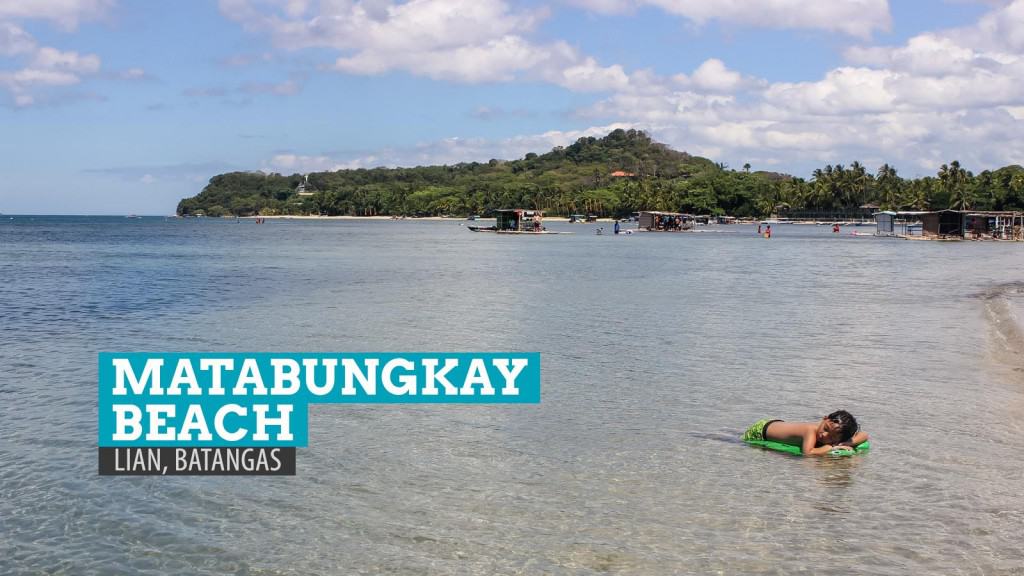A worldful of grays are scattered along the shore of Matabungkay. It is strewn with ashen sand that sparkles a white glow when hugged by sunlight. It is bordered landward by a long, cramped lane of resorts and stores. Many times, it is littered with trash that unabashed locals and tourists left behind. And lying on the berm, almost safe from the swashes of the struggling tides, are memories — neither fresh nor stale — that I always come back for.
I always find myself lazing on the beach of Matabungkay. Sometimes with friends. Other times, just me. My last visit was almost a year ago, April 2012. There’s just a hole in my heart that only the sand of this place can fill.
The Beach
I grew up in Batangas, and I had always heard of its name since I was a kid. But my first time to set foot on this place was when I was already working here. It was famed for being a sanctuary, a place that lights up the spirit and boasts a lighter gray sand. Hidden along the western shore of the province, facing the West Philippine Sea, it was for the longest time an idyllic fishing village until tourism changed it completely.
Legend has it that Matabungkay was “rediscovered” in the early 1950s by Germans who were looking for a go-to paradise within proximity to the bustling Manila. Slowly it gained prominence and for a long period became the “it” destination in Southern Luzon, way before the rebirth of Anawangin or the rise of Caramoan.
Today, Matabungkay is not as famous, but it continues to offer refuge to work-battered capital-dwellers aching for a respite and families wanting an easy getaway. One thing that’s going for it is its accessibility — only two hours away.
Posted: 2013 • 3 • 16
The Crowd
In our town, going to Matabungkay, despite its being just over an hour away, was a dream. I remember, when I was a kid my mom would always tell my siblings and I how expensive it was to go on a vacation there whenever we brought it up. Of course, things are different now. For starters, we can already afford to stay there. Plus, a lot of cheaper resorts and inns have mushroomed along the shore through the years. Its proximity coupled with affordability had brought in a lot of tourists, providing livelihood to the locals and changing the face of the place along the way.
Those who are looking for a quiet, secluded paradise will be disappointed by the commercialism that had taken over it. Stores are everywhere and vendors of souvenirs approach guests, sometimes persistently. These floating huts have become almost a fixture that it’s almost impossible to take a shot without them in the frame.
But those patient to find a good spot are rewarded. For example, Matabungkay Beach Hotel’s beachfront is bookmarked by runways that extend to the sea, drawing a border between the pricey resort and the rest of the beach.
At night, your elusive peace of mind might be chased away by the ubiquitous showstopping videoke/karaoke performances, good and bad, that play in the background.
The Trash
In the many times that I returned to Matabungkay, one thing that is constant is the trash. Each time, I spotted food leftovers, plastic wrappers, disposable plates and cups, glass bottles, and cigarette butts. I know that you find these in many other beaches in and out of the country but they’re glaring here — because of both the size and the number. It was actually Matabungkay that inspired me and my teammates at PhilippineBeaches.org to launch a Responsible Travel campaign.
The last time I was here, the condition was a lot better, but it definitely has seen better days. Still, it’s a good sign. At least I know that the environmental fee that they have started collecting is going somewhere. Again, it’s been a year since my last visit and I can’t speak about its current state. I hope it’s better now.
The Memories
My very first serious job sent me and had me stay in Matabungkay in Lian, Batangas for two months. I had just graduated from college, and it was my debut to the corporate world. Part of my job was to manage a group of Korean students studying English at Matabungkay Beach Resort. Those two months were filled with unforgettable experiences with the kids and my co-workers. Although the hectic schedule did not allow me to get out of the resort often, it did not stop me from creating fun memories here. That was in early 2007.
I had never seen many of those Korean and Filipino kids and colleagues again since then. Even despite exchanging emails, there is still something missing, something that may be the music of voices or the warmth of physical presence. Looking back, I can’t believe just how close I was to them and appalled by how distant we now are. It’s like our friendship only existed during the two months that they were near, that they were here. Six years later, when contacts have been lost and links severed, there is only one place to relive those days — on the beach of Matabu
ngkay, among the trash and the crowd and the ashen sand that once was scarred by our footprints.
How to get to Matabungkay: If driving, from SLEX, take Sta Rosa Exit, Silang-Tagaytay Highway, and continue until you reach the Batangas-Cavite border. Turn right onto the road under the Nasugbu arc until you reach Shell gas station, turn left towards the direction of Lian and Calatagan. Watch out for a Matabungkay signage on your right hand side.
If taking public transportation, take a van (shuttle) or bus going to Calatagan or Lian at EDSA-Taft (near Pasay Rotonda and Metropoint Mall). Simply tell the driver/conductor to drop you off at the junction to Matabungkay. From there, take a tricycle.
